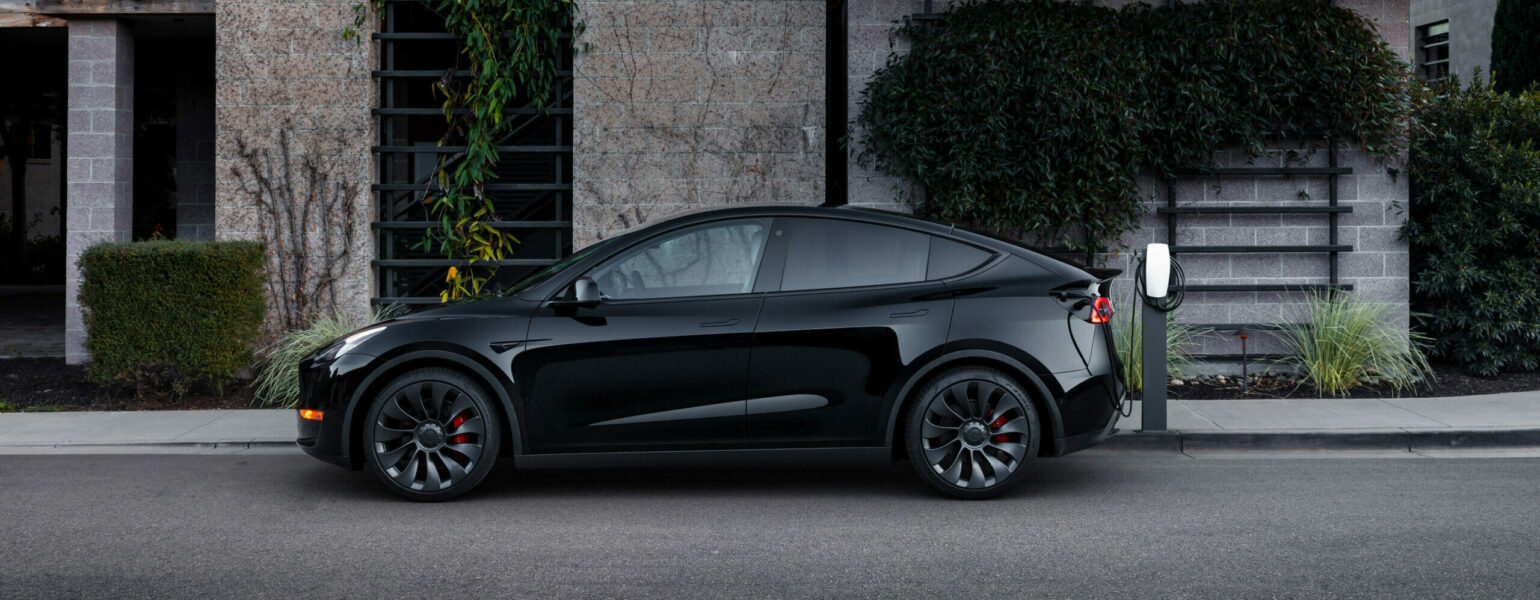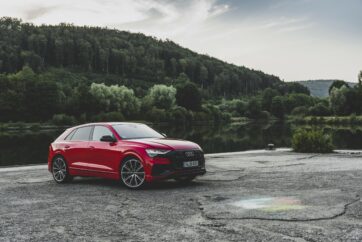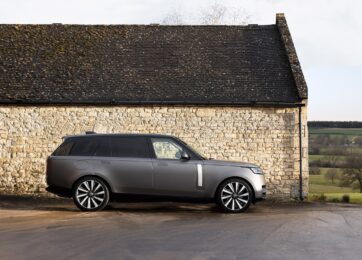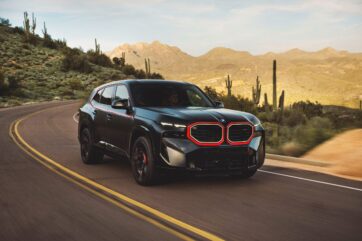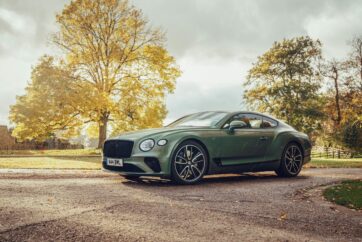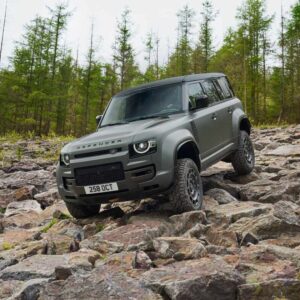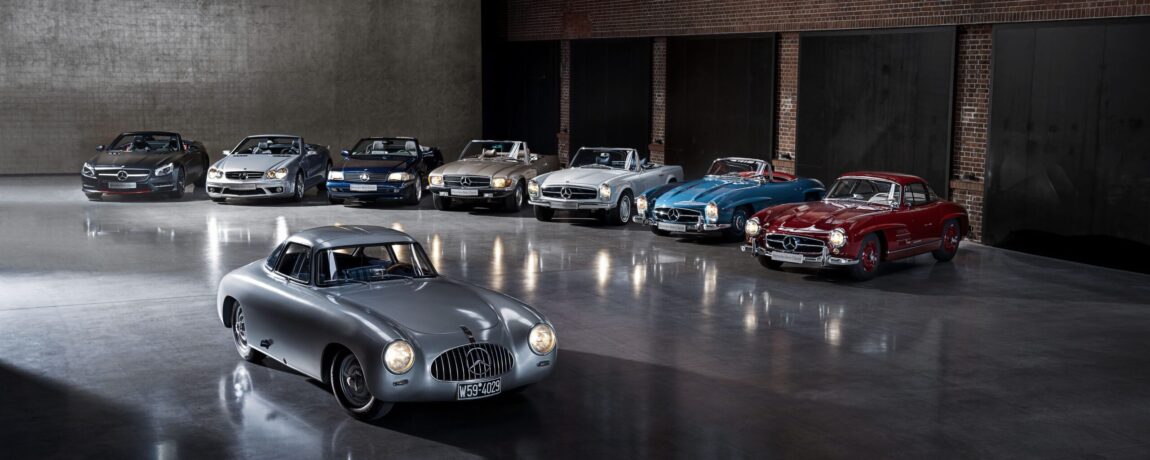
Happy 70th Birthday Mercedes Benz SL
There are many models of car that have seen their legendary badge run for decade after decade confirming their iconic status. Think of names such as the 911, the Defender, the Mini Cooper or even the Fiat 500 and despite their differences you cannot deny they are all a piece of motoring history. This year saw another of those legendary names turn 70 years old and for that length of time, has been one of the most desirable cars money can buy. Not only that, but some of the early models are some of the most sought after cars to add to any classic car collection.
At the 1954 New York Auto Show at Madison Square Garden a main hall of 92 cars from Lancia, Jaguar, Alfa Romeo, Hillmans, Austins and Fords were accompanied by prototypes from Mercedes Benz in the form of the 300 SL and 190 SL.
1954 Mercedes Benz 300 SL
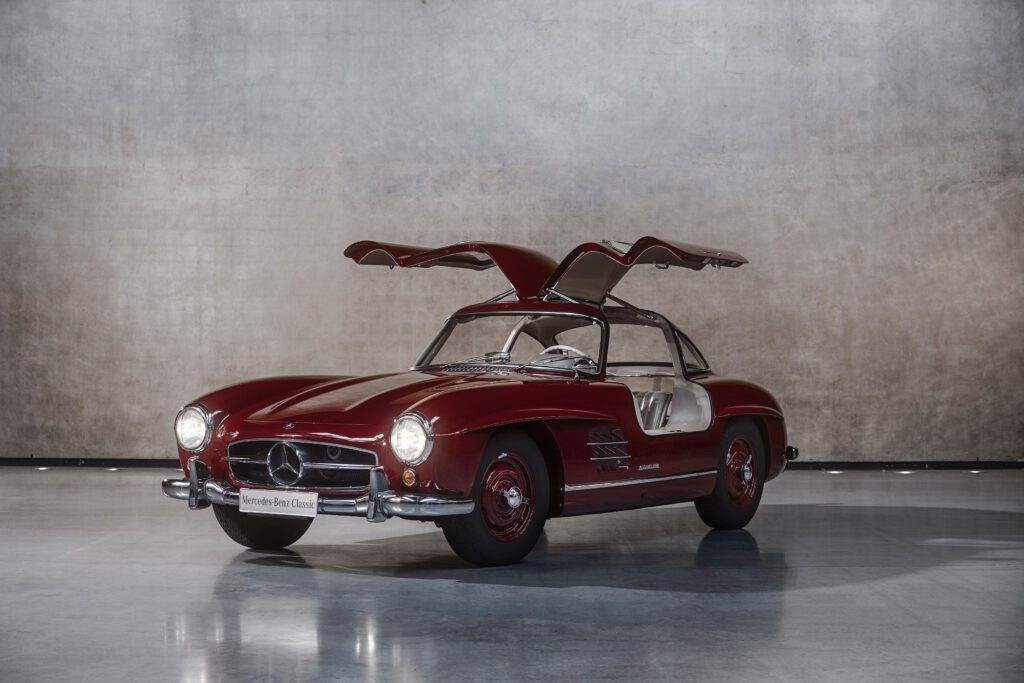
Originally never intended to be anything other than a racing car in the form of the W194, the road going 300 SL was created for wealthy performance car enthusiasts in the American market. The ‘SL’ naming, although never officially confirmed, is believed to stand for ‘Sport Leicht’ (or Sport Light). Its steel tubular frame chassis combined with aluminium body panels meant the 300 SL was extremely light, whilst the 3.0-litre straight six installed in such a streamlined body meant that it was the fastest production car of its time, with a top speed of 163mph.
The 300 SL in various forms was an extremely successful racing car in its day, taking victories in the European Rally Championship, the Sports Car Club of America Championship, the Targa Florio and the iconic Mille Miglia at the hands of Stirling Moss in a 300 SLR. The iconic 300 SLR spawned two road-legal coupes, one of which became the most expensive car ever sold at auction, selling for a substantial £115million at a 2022 RM Sotheby’s sale.
With its sleek aerodynamic styling, long bonnet and trademark gullwing doors, the 300 SL was produced from 1954 to 1963, with 3,258 built in both coupe and roadster forms. Its popularity and desirability as well as its stunning design means that the 300 SL is one of the most sought-after additions to any classic car collection. Notable owners over the years have included Juan Manuel Fangio, Pablo Picasso, Sophia Loren, Ralph Lauren, Frank Lloyd Wright, Clark Gable and many more.
1954 Mercedes Benz 190 SL (W121 BII)
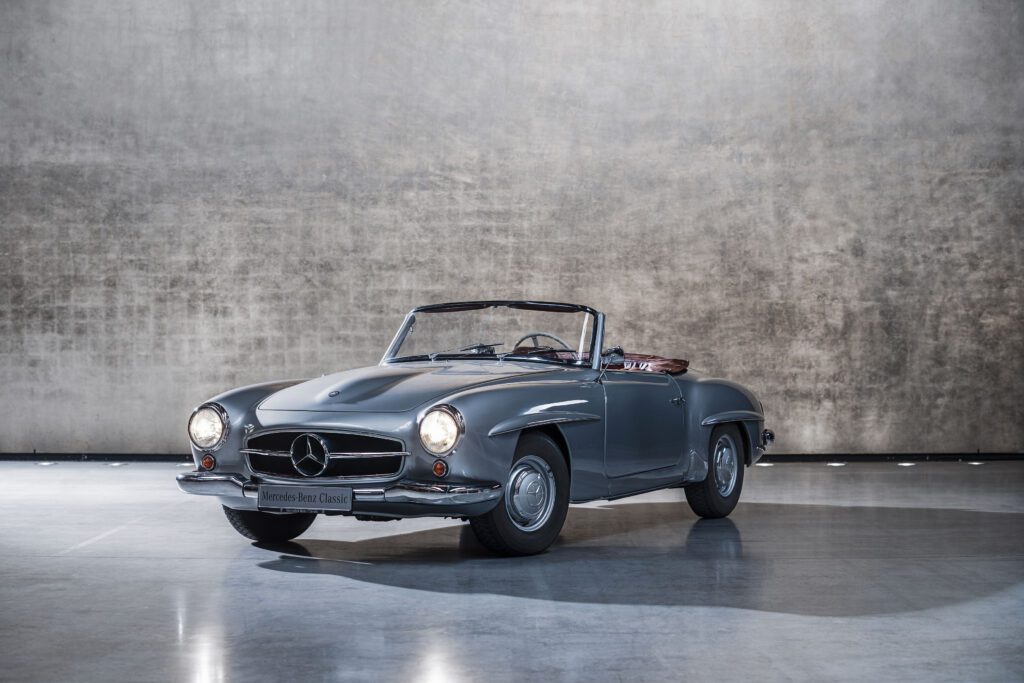
The 190 SL was created as a more affordable alternative to the racing car derived 300 SL. With similar styling, engineering, suspension and design details, the underpinnings came from a shortened version of the W121 saloon chassis rather than the bespoke tubular frame of the 300 SL. Intended to be more of a convertible sports car or long distance grand tourer, the 190 SL came with a convertible roof or removable hard top but not a coupe.
Its 1.9-litre straight-four engine was derived from the straight-six in the 300 SL and produced 105bhp, half the power output. Despite sharing a lot of the styling and engineering influences, the 190 SL cost a third less than the coupe form and less than half of the price of the convertible 300 SL. This of course meant that it was extremely popular, and Mercedes Benz sold more than 25,000 examples over the 8 year production run.
1963 Mercedes Benz W113
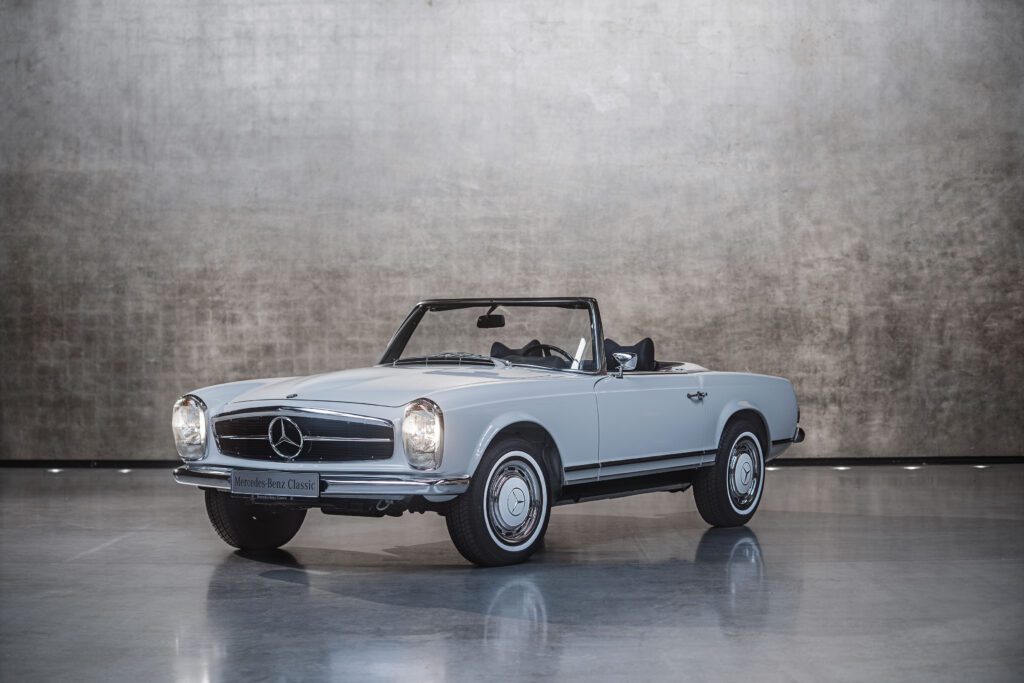
Introduced at the 1963 Geneva Motor Show, the W113 replaced both the 300 SL and 190 SL. Concerns over the lack of performance from the 190 SL and the fact that the 300 SL was only a possibility for the most affluent of buyers, the W113 generation was designed to offer a bit from both models. Created as a ‘very safe and fast sports car with high performance’ and ‘a very high degree of travelling comfort’, it was a huge step forward in so many areas. The design of its slightly concave removable hardtop, designed for improved access to the cabin, gave birth to the ‘Pagoda’ nickname of the W113 model that remains to this day.
The W113 was the first sports car that offered a rigid passenger cell, designated crumple zones and impact absorbing sections built into the structure. It was the first Mercedes Benz to offer radial tyres for better handling and grip levels, had a sophisticated suspension system for its time and featured front disc brakes with power assisted rear drums. The 2.3-litre inline-six engine offered at launch produced 148bhp, almost 50% more than the previous generation.
Chief Engineer Rudolf Ulenhaut demonstrated the capabilities of the model by lapping the now disappeared three-quarter mile Vétraz-Monthoux race track in southern France in almost the same time as a 3-litre V12 Ferrari 250 GT driven by British racing driver Mike Parkes.
In 1966 the 250 SL was introduced with a larger 2.5-litre engine providing the same power output but greater torque, as well as rear disc brakes and better cooling, resulting in notably improved performance. It also brought about the introduction of the SL ‘California’ a year later, with the removal of the folding soft top, replaced by a fold down rear bench seat for 2+2 functionality, and just the removable hard top remaining. In December 1967 a 280 SL was introduced offering a larger 2.8-litre engine and a power output increase to almost 170bhp.
Of the 48,912 W113 SL’s that were built over an 8-year production run, two-fifths were sold to the US market. By the time the model was due for replacement in 1971 the SL had firmly become more of a powerful grand tourer than a sporty and lightweight focused model. Notable famous owners of this iteration of SL were Juan Manuel Fangio, Walt Disney, Priscilla Presley, Stirling Moss, Sophia Loren, John Lennon and more recently Kate Moss, David Coulthard and Nico Rosberg.
1971 Mercedes Benz R107/C107
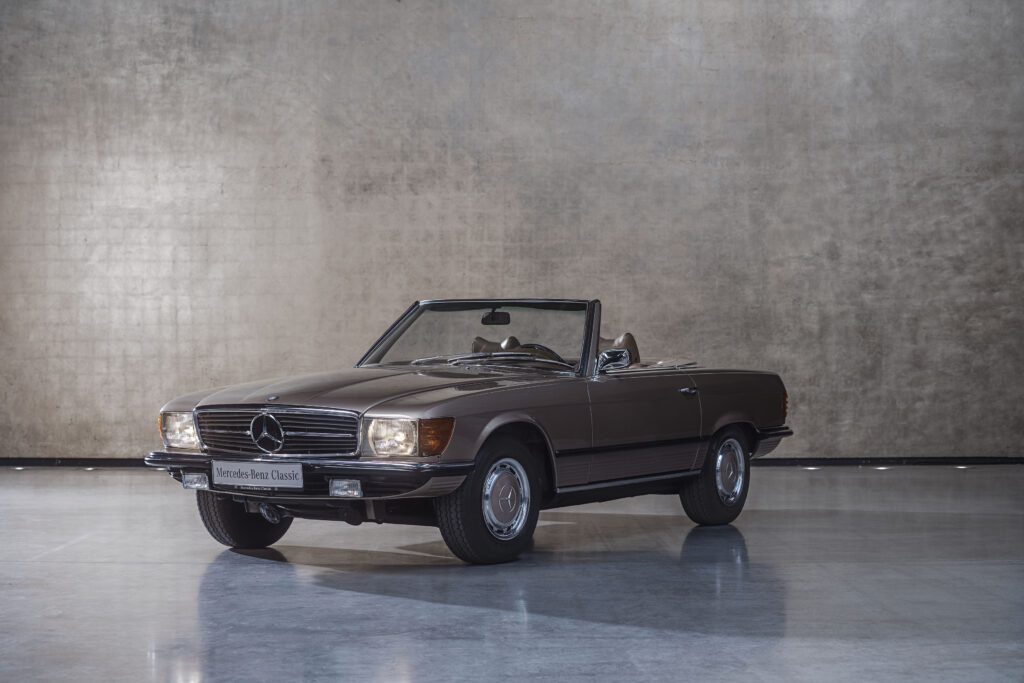
The grand touring focus that the previous generation had evolved into meant that the following model was longer and heavier in a bid to provide greater luxury and comfort. The R107/C107 also was aimed more at the American market due to the success of its predecessor across the pond. Offered as the R107 in convertible/roadster form with standard foldable soft top and optional removable hardtop, and the C107 (also called SLC) with a hardtop coupe form and rear seating.
At launch the car was available with a 3.5-litre V8 engine, the 350 SL, which was then joined by a 2.8-litre straight-six in 1974 in the form of the 280 SL. By 1977 a 450 SL 5.0-litre joined the lineup, produced as a homologation car to allow entry into the 1978 World Rally Championship, and in 1980 the 500 SLC. The greater power from the larger engines was due to an attempt to offset the additional weight, with over 180bhp offered by the smallest engine 280 SL and almost 240bhp on offer from the 500 SL.
With a production run that started in 1971 and didn’t end until 1989, the R107/C107 iteration of SL was the longest single series ever produced by the car maker other than the G-Class. Over the 18 years they were built, just over 300,000 R107/C107 models were built, with almost 70% of those sold in the US.
1988 Mercedes Benz R129
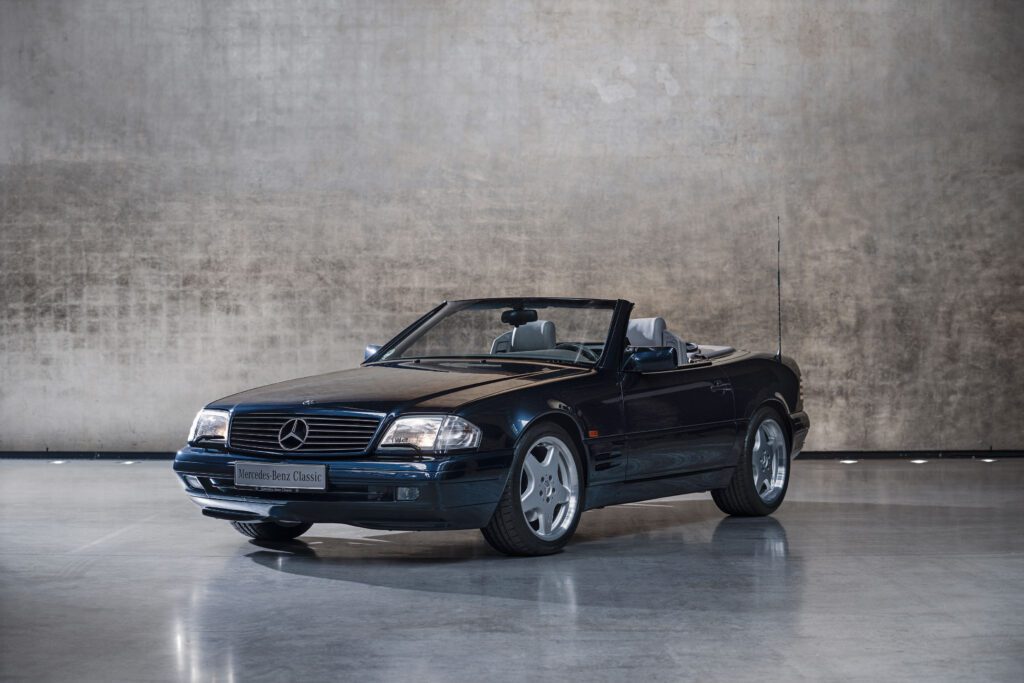
Despite being designed four years earlier in 1984, the 1988 R129 SL featured many innovative details for its time. With a multi-link rear axle, electronically controlled damping to the suspension and an automatically extending roll-over bar that remained hidden unless required. It was also the first passenger car to have seatbelts integrated into the seat instead of being anchored to the floor, and came with electrically operated windows, seats, mirrors and roof operation as standard. It was offered only as a convertible with a colour-matched soft top roof, but also with an optional detachable hard top fitted whilst the soft top was lowered.
Upon launch there were 3 engine choices available, a 188bhp 3.0-litre 300 SL, a 228bhp 3.0-litre 300 SL-24 and the 5.0-litre V8 500 SL that produced 322bhp. In 1992 a 6.0-litre V12 engine was fitted to create the 600 SL that produced almost 400bhp. At this time, AMG were still operating as an independent company and produced a variety of even more powerful variants, from the SL 60 AMG offering 375bhp from a 6.0-litre V8, the SL 72 AMG offering over 500nhp from a 7.1-litre V12 engine and the extremely rare SL 73 AMG that was equipped with a 7.3-litre V12 engine producing almost 520bhp. The latter also providing the same engine for the Pagani Zonda.
The R129 iteration of SL was produced from 1988 to 2001 and in that time sold just over 213,000 examples. Over that time, it received an array of special editions from the Mille Miglia Edition to the Silver Arrow Edition, 40th Anniversary Edition, F1 Edition, Final Edition and many more. It was notably the first foreign car to be used by the royal family after Diana, Princess of Wales swapped her Jaguar XJS for a metallic Red 500 SL, a car that now resides in the Mercedes Benz Museum.
2001 Mercedes Benz R230
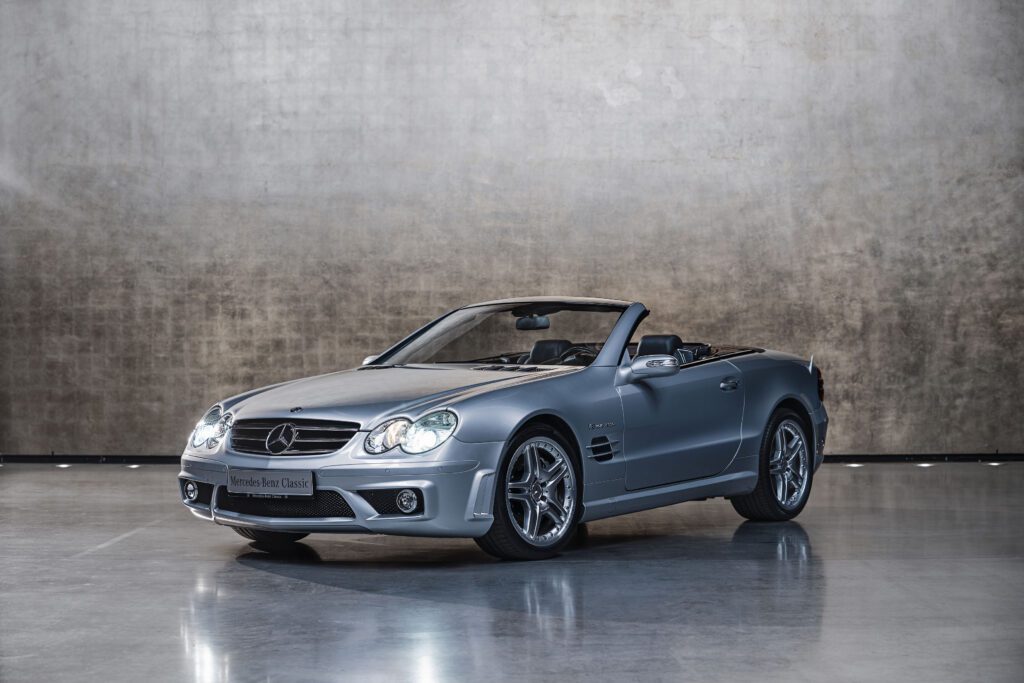
The R230 was unique in that it was one of the first cars to be designed both as a scale model but also in a virtual capacity at the same time. Draft designs were submitted from no fewer than 10 designers in Germany, California and Japan resulting in hundreds of sketches being entered. 12 quarter scale models were then produced and digitised for computer manipulation with a state-of-the-art computer processing technology virtual environment.
The R230 was unveiled as the Safety Car at the 2001 Formula 1 Hockenheim Grand Prix in Germany some five years after development began. It came with a folding hard-top roof only and was no longer offered with a soft top. At launch there ere 3 engines to choose from, the 3.7-litre V6 SL 350 that produced 242bhp, the 5-litre V8 SL 500 producing 302bhp and the SL 55 AMG (with AMG now an in-house tuning company) featuring a 5.4-litre supercharged V8 with 493bhp. In 2003 these were joined by the 5.5-litre bi-turbo V12 SL 600 producing 493bhp and in 2004 saw the addition of the 6.0-litre bi-turbo V12 engine SL 65 AMG that produced over 600bhp.
The mid-life facelift of 2008 saw a more aggressive and angular appearance as well as considerable power upgrades across the range. It also saw the addition of the high-performance coupe only SL 65 AMG Black Series with an almost 10% power upgrade, 250kg saving in weight and wider carbon fibre bodywork. It could accelerate from 0-62mph in just 3.8 seconds and had a top speed of over 200mph. During its 10-year production run the R230 version of the SL sold almost 170,000 cars.
2012 Mercedes Benz R231
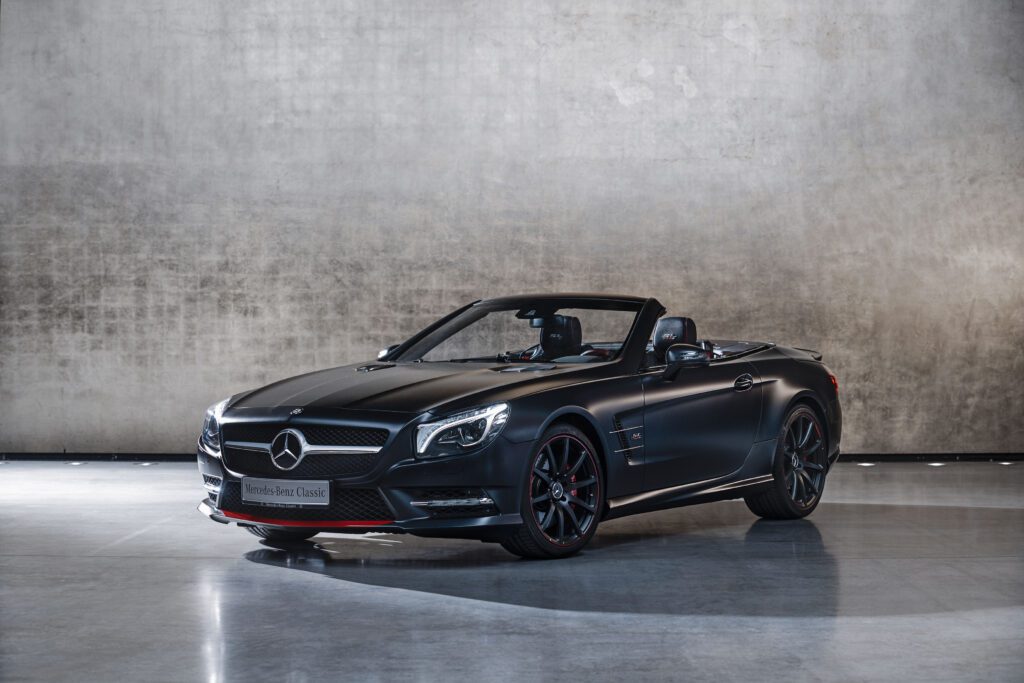
The sixth generation of SL saw an attempt to return to its roots of saving weight. Thanks to being made almost entirely of aluminium, the R231 was 140kg lighter than its predecessor despite being longer and wider. Again, offered with a folding hard top roof only, its sleeker styling was more of an evolution from the previous generation rather than a complete overhaul, especially from the rear where the cars look very similar.
The minor changes to the exterior however hid the overhaul to not only the interior but the levels of equipment and features that the latest iteration could be specified with. It featured an array of the latest advanced technological features from the Magic Sky Control selectable transparency glass roof, Active Body Control with adaptive damping system and a plethora of driver assist systems to ensure your journey is as comfortable and trouble free as possible.
At launch the car was equipped with the 3.5-litre 302bhp V6 engine in the SL 350, the all-new 4.7-litre bi-turbo V8 producing 430bhp in the SL 500, a 5.5-litre bi-turbo V8 producing 530bhp in the SL 63 AMG and the 621bhp 6.0-litre bi-turbo V12 in the SL 65 AMG. The R231 was in production for 8 years before being replaced by the 7th and current version of the iconic badge, the R232.
Mercedes Benz R232
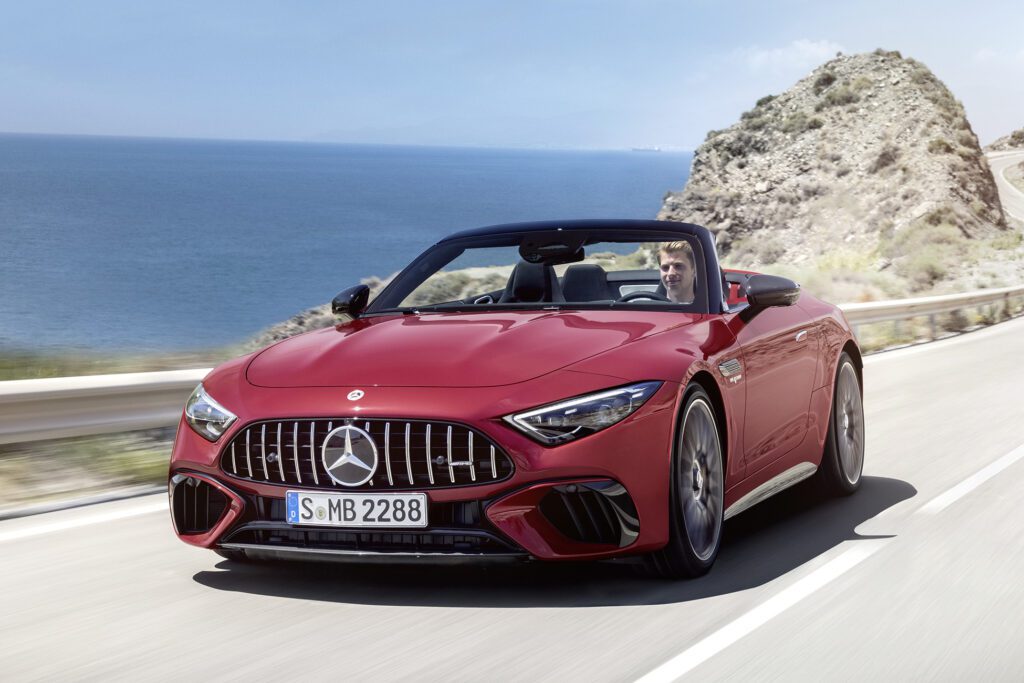
The latest version of the SL has seen some of the biggest changes in over 30 years, and in some respects the biggest changes yet. For starters the model is now marketed under the AMG brand and is a replacement for the convertible version of the AMG GT, the roadster. It features their more angular styling in appearance as well as their brand-new interior design and the latest advanced technology.
Speaking of being a convertible, the fabric convertible roof has returned replacing the metal folding hard top and saving 21kg in the process, which in turn lowers the centre of gravity improving handling. The dynamics of the car has been quite a focus with the AMG developed all-aluminium platform being both lighter yet 50% more rigid than the previous model. It also now features 2+2 seating as standard thanks to being longer and wider than the outgoing model.
At launch there are two engine types available, both of the combustion engines featuring bi-turbo 4.0-litre V8 engines, but with either 469bhp in the SL 55 or 577bhp in the SL 63. In what is the biggest change to the powerplant for the SL, it is also offered with a 2.0-litre four-cylinder engine with hybrid assistance in the form of the SL 43, with a power output of 375bhp. This is the first time an inline 4-cylinder engine has been used in the SL since the original 190 SL from 1954, but also the first time hybrid assistance has also been used.
Whilst the 4-cylinder mild hybrid variant is designed to save fuel and allow efficient driving, Mercedes have also recently announced the SL 63 E Performance at the opposite end of the spectrum. With the same 4.0-litre V8 as the SL 63 it also has a 201bhp electric motor and battery technology developed in collaboration with their F1 team to offer a combined 804bhp and over 1,000lb ft of torque. It is expected to be able to accelerate to 62mph in less than 3 seconds and have a top speed of almost 200mph.
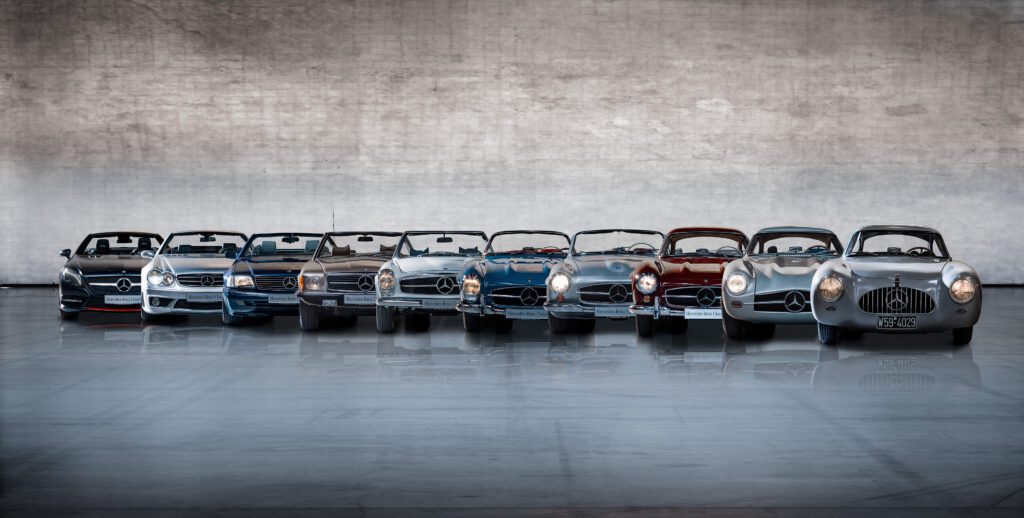
The Mercedes Benz SL is one of the most iconic sports cars of all time and its desirability amongst car collectors and sports car fans is only growing over time. It may now be larger and more technologically advanced than ever before, but thanks to a return to focusing on driving dynamics, it remains one of the finest sports cars money can buy that is more than capable of being used as a grand touring cruiser. Whatever iteration of SL you prefer, you can be sure that it will offer effortless driving with refinement and comfort that many other sports cars cannot match. Roof up or roof down, cruising around in an SL Mercedes Benz is certainly one of the most stylish ways to get around.
Oracle Mercedes Benz Finance
At Oracle Finance we love a Mercedes Benz, last year it was our fourth most popular brand that we funded and we sourced finance for over 540 Mercedes Benz models including many rare or desirable classic models. Our expert Account Managers use our panel of specialist lenders to help you to find the perfect package, bespoke to you and your circumstances. Read more about our Mercedes Benz Finance here: Mercedes Benz Car Finance
Why Choose Oracle?
With over 2,000 Trustpilot reviews and an average rating of 5 out of 5, you too can find out why thousands of people trust us time and time again to find a smarter, tailored funding solution when looking for your next dream car. We have also been awarded ‘Best Specialist Car Finance Provider’ four years in a row at the Car Finance Awards 2020, 2021, 2022 and 2023 having funded over £1.9 billion of vehicles over 18 years and counting.
Make sure you follow us on Instagram, LinkedIn and Facebook to keep up to date with what’s happening in the market and to see some stunning photos and videos of the amazing cars we fund.
